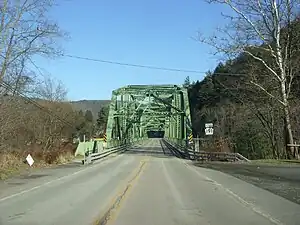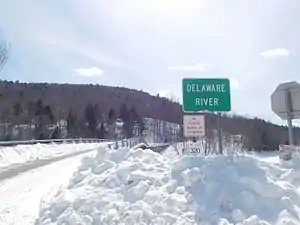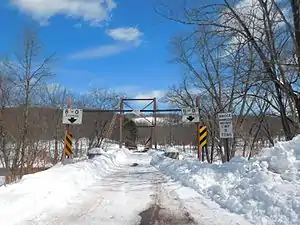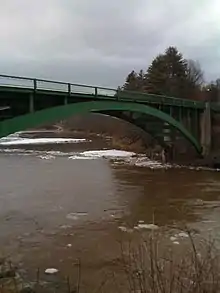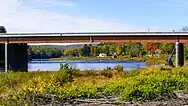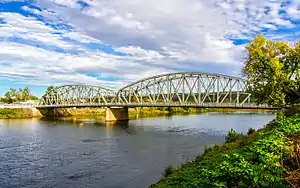| Interstate agency overview | |
|---|---|
| Formed | May 1919 |
| Jurisdiction | New York and Pennsylvania |
The New York–Pennsylvania Joint Interstate Bridge Commission, or simply the Joint Interstate Bridge Commission, is an interstate agency jointly owned by the states of New York and Pennsylvania. The commission was formed in 1919 by the two states to manage the crossings of the Delaware River that connected them.[1] It currently maintains and operates 10 toll-free bridges from the New Jersey–Pennsylvania state line to the end of Pennsylvania and New York's shared border along the Delaware River.[2]
History
In 1919, an idea for a commission to manage the bridges between New York and Pennsylvania was proposed by state officials. A meeting was called by the New York Commission in May 1919 to establish the New York–Pennsylvania Joint Interstate Bridge Commission. Promptly, the existing bridges spanning the Delaware River were examined so that their value could be assessed and they could be purchased. Within the next five years, almost all of the existing bridges spanning the Delaware River between New York and Pennsylvania were owned and operated by the newly founded commission.[1]
Bridges
From north to south:
- Lake Como-Hancock Bridge[3]
The Lake Como–Hancock Bridge, commonly referred to as the Hancock Bridge is a series of two bridges crossing the east and west branches of the Delaware River after the river splits at Hancock, New York - Lordville–Equinunk Bridge[4]
The Lordville–Equinunk Bridge is a girder bridge that connects Lordville, New York with Equinunk, Pennsylvania, United States over the Delaware River. - Kellams Bridge
The Kellams Bridge, also known as the Little Equinunk Bridge and Kellams–Stalker Bridge, is an underspanned suspension bridge spanning the Delaware River between Stalker, Pennsylvania, and Hankins, New York. - Callicoon Bridge[5]
The Callicoon Bridge carries vehicles and pedestrians across the Delaware River between the unincorporated hamlet of Callicoon in the town of Delaware, part of Sullivan County, New York, and Damascus Township in Wayne County, Pennsylvania, both in the United States. It is a multi-girder structure of steel and concrete. - Cochecton–Damascus Bridge[6]
The Cochecton–Damascus Bridge, sometimes called the Cochecton Dam Road Bridge, crosses the Delaware River in the United States between the unincorporated hamlet of Cochecton, in Sullivan County, New York, and Damascus Township, in Wayne County, Pennsylvania. On the Pennsylvania side it is the eastern terminus of State Route 371; in New York its approach road is County Route 114. - Skinners Falls–Milanville Bridge[7]
The Skinners Falls–Milanville Bridge is a bridge spanning the Delaware River between Milanville, Pennsylvania, and Skinners Falls, New York, in Wayne County, Pennsylvania, and Sullivan County, New York. The bridge is 470 feet (140 m) long and holds one single lane of Skinners Falls Road. - Narrowsburg–Darbytown Bridge[8]
The Narrowsburg–Darbytown Bridge is an arch under bridge spanning the Delaware River between Darbytown, Pennsylvania, and Narrowsburg, New York. It carries Pennsylvania Route 652 and New York State Route 52. - Barryville–Shohola Bridge[9]
The Barryville–Shohola Bridge is the fifth generation of bridges constructed over the Delaware River at the communities of Shohola Township, Pennsylvania, and Barryville, New York. The bridge serves both communities, with two major state legislative highways, Pennsylvania Traffic Route 434 and New York State Touring Route 55 (along with the co-designation of Sullivan County Route 11). - Pond Eddy Bridge[10]
The Pond Eddy Bridge is a petit truss bridge spanning the Delaware River between the hamlet of Pond Eddy in Lumberland, New York, and the settlement informally called Pond Eddy in Shohola Township, Pennsylvania. It is accessible from NY 97 in Lumberland on the New York side and two dead-end local roads, Flagstone Road (State Route 1011) and Rosa Road on the Pennsylvania side. - Mid-Delaware Bridge[11]
The Mid-Delaware Bridge, sometimes known as the Port Jervis–Matamoras Bridge or the Fourth Barrett Bridge, is a continuous truss bridge which carries U.S. Route 6 (US 6) and US 209 across that river between those two communities and thus the states of New York and Pennsylvania. It is the only four-lane bridge on the upper main stem of the Delaware.[12]
See also
References
- 1 2 New York State Legislature (1923). New York Legislative Documents.
- ↑ "NY–PA Joint Interstate Bridge Commission Updates Status of Upper Delaware Bridges". Upper Delaware Council. Retrieved July 12, 2020.
- ↑ New York State Legislature (1923). New York Legislative Documents.
- ↑ Dale, Frank T. (2003). Bridges Over the Delaware River: A History of Crossings. Rutgers University Press. ISBN 978-0-8135-3213-4.
- ↑ Dale, Frank T. (2003). Bridges Over the Delaware River: A History of Crossings. Rutgers University Press. ISBN 978-0-8135-3213-4.
- ↑ New York State Legislature (1923). Legislative Document. J.B. Lyon Company.
- ↑ Pennsylvania Office of the Attorney General (1923). Report of the Attorney General of Pennsylvania for the Two Years Ending December 31: 1921–1922. Office of the Attorney General.
- ↑ Hawker, Arthur J. Tusten to 1900. Narrowsburg, New York.
- ↑ Pennsylvania Office of the Attorney General (1923). Report of the Attorney General of Pennsylvania for the Two Years Ending December 31: 1921–1922. Office of the Attorney General.
- ↑ New York State Legislature (1923). Legislative Document. J.B. Lyon Company.
- ↑ Pennsylvania Office of the Attorney General (1923). Report of the Attorney General of Pennsylvania for the Two Years Ending December 31: 1921–1922. Office of the Attorney General.
- ↑ "Arbeitsblatt 3". www.karl-gotsch.de. Retrieved July 12, 2020.
